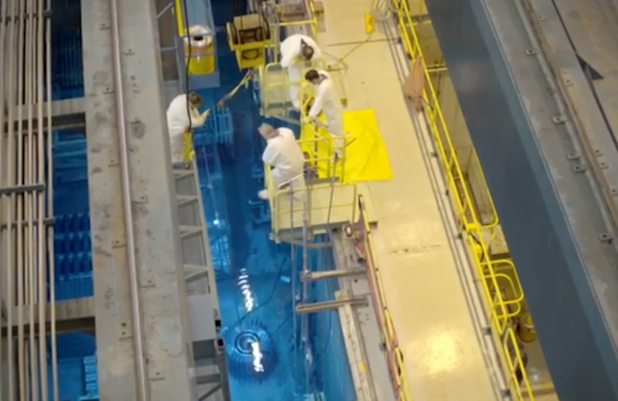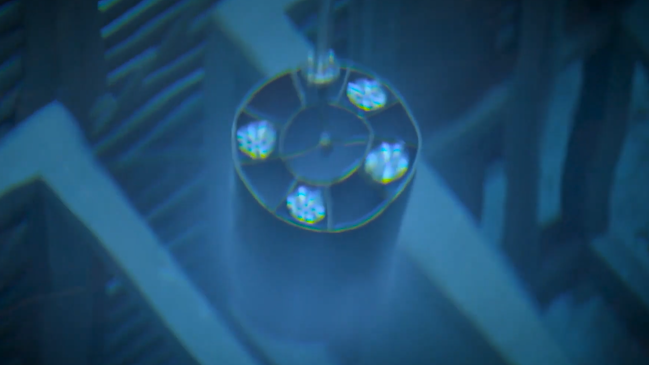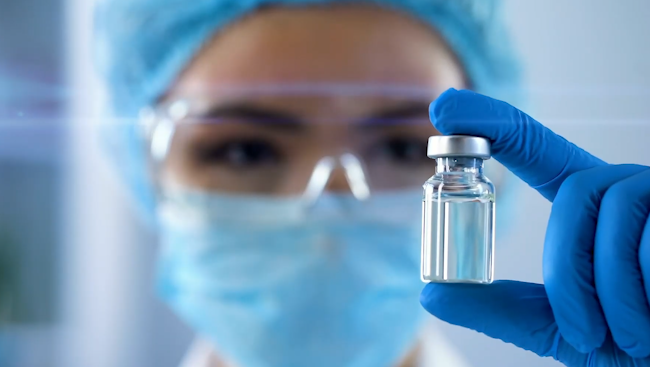Bruce Power looks to expand radioisotope offering
Bruce Power has set out its plans to expand production of medical radioisotopes in its Candu reactors. As well as increasing long-term lutetium-177 production capacity, the company also wants to explore the production of other isotopes using its proprietary system.
_11853.jpg)
Following on from the completion of two years' commercial production of lutetium-177 (Lu-177) using the Isotope Production System (IPS) at Bruce 7, the company set out its intentions in a 31 October letter to the Canadian Nuclear Safety Commission (CNSC). The system has proven its safety and reliability, the company said, with no missed shipments since launch. A second production line on Bruce 7's IPS is now in service, doubling production capacity. Lu-177 is used to treat certain tumours and prostate cancer.
Bruce Power said it now plans to add an additional Isotope Production System on unit 6 in 2027 to increase long-term capacity and also maintain production when Bruce 7 is taken offline for its Major Component Replacement (MCR) outage which is scheduled for 2028-2031. The company will also evaluate the feasibility of a third Isotope Production System (IPS) at the Bruce A plant (Bruce units 1-4), to be installed in 2029.
Units 5-8 - known as the Bruce B reactors - also produce cobalt-60 which is used for sterilisation and the treatment of brain tumours and breast cancer. The MCR and outage programme at Bruce B "is both securing the supply of cobalt-60 through 2064, and installed modifications have increased production", the company told the CNSC.
Bruce Power said it is "committed to exploring additional isotope production using our system and plans to propose an amendment to its operating licence to add multiple new isotopes in a bounding approach for the IPS". It intends to submit a licence amendment for multiple new isotopes in 2025.
Investing locally
Bruce Power partnered with Isogen (a jointly owned company of Kinectrics Inc and Framatome Canada) to install the Isotope Production System on Bruce 7. Lu-177 produced at Bruce 7 is transported to ITM Isotope Technologies Munich SE (ITM)'s facilities in Germany for processing. Its Gamzook'aamin aakoziwin partnership with the Saugeen Ojibway Nation (SON), was set up in 2019 to jointly market new medical isotopes while creating new economic opportunities within the SON territory by establishing new isotope infrastructure.
In collaboration with the Southwestern Ontario Isotope Coalition, IsoGen and SON, the company said it was committed to advocating for processing facilities to be built locally to enhance the supply chain of isotopes in Ontario and improve the logistical impacts of handling short-lived medical isotopes. "In 2025, we will be investing CAD3 million (USD2.2 million) into greater localisation and will be proposing to the CNSC changes to existing licensed facilities to safely accommodate this important work," it said.
"Southwestern Ontario, the rest of the province and the country have become global superpowers in the production of medical isotopes through innovation, partnerships, investment and stakeholder support," said Bruce Power Chief Operating Officer and Executive Vice-President James Scongack, adding that maximising isotope production and exploring the production of other medical isotopes "is the socially responsible thing to do for patients around the world."
Bruce Power Is Expanding Its Medical Isotope Program

Energy Minister Stephen Lecce. Image courtesy of Bruce Power
Ontario Energy Minister Stephen Lecce was at Bruce Power in Tiverton today for the announcement of an expansion of the nuclear operator’s medical isotope program.
A new hot cell will be constructed to process the cancer-fighting medical isotope lutetium-177 which is used as a targeted therapy, including for prostate cancer and neuroendocrine tumours.
The Ontario government says, “By repatriating medical isotope processing to the province and building provincial capacity to process the isotopes produced at our nuclear stations, Ontario is cementing its position as a leader in this cutting-edge medical field.” Right now, they’re processed in Germany.
The hot cell at Bruce Power will support the initial processing of lutetium-177 that involves removing the aluminum carriers to extract the lutetium, known as ‘decladding.’ Bruce Power has commissioned a second production line in its Unit 7 Isotope Production System, which will double lutetium-177 production capacity on Unit 7.
Bruce Power will partner with Isogen to construct this new hot cell and will also work with the Saugeen Ojibway Nation to build upon the existing Gamzook’aamin aakoziwin isotope partnership.
In addition, Bruce Power will begin the refurbishment of Unit 4 on February 1, 2025, while refurbishment of Unit 3 is already underway.
In total, Ontario is planning to refurbish a total of six Bruce units (Units 3 to 8) by 2033, which will extend their operating lives for at least another 30 years.
Progressive Conservative Member of Provincial Parliament for Huron-Bruce Lisa Thompson says in a statement, “Today’s announcements demonstrate that communities in Bruce, Grey and Huron Counties are proving that rural Ontario has the capacity, the talent and genuine desire to support the development of global-leading, cancer-fighting technologies, in addition to growing the production of clean, affordable energy that will position the province to confidently build for future growth and prosperity.”
Chippewas of Nawash Unceded First Nation Chief Greg Nadjiwon, says in a statement, “We’re proud to be part of this unique partnership that is not only helping to fight cancer on a global scale, but is a step forward in economic participation in meaningful projects in our Territory that will support us in implementing our vision for our communities.”
Medical isotopes created in Bruce County
will no longer be shipped overseas for
processing
Scott Miller
CTV News London
Published Nov. 8, 2024
Bruce Power is quickly becoming one of the world’s largest producers of medical isotopes that fight and detect cancer around the globe – but on Friday the government and nuclear operator announced that they are working together to start processing those medical isotopes within Bruce County instead of shipping them overseas for processing.
“We're going to add some facilities either on site or very close to site to process these isotopes, which are coming outside of the reactor. [That means] we can get them into the drug much much faster, and go to the patient as fast as possible,” said Bruce Power CEO and President, Eric Chassard.
The new medical isotope processing facility will be located either right on the Bruce Power site, or in the Bruce Energy Centre near the nuclear plant. This means that instead of shipping the medical isotopes all the way to Germany for processing like they were previously, they’ll be processed within a few hundred metres of where they’re produced.
 Medical isotope production at Bruce Power nuclear station near Kincardine (Source: Bruce Power)
Medical isotope production at Bruce Power nuclear station near Kincardine (Source: Bruce Power)RELATED STORIESIsotope production line 'doubling' at Bruce Power
Nuclear Waste Series: Polarizing community views about nuclear waste plan as vote nears
Bruce Power hopes to increase capacity by 73 per cent with Bruce C development
“What this means is that we're saving time - and when you're producing these medical isotopes, that time is money. And the closer we can get these medical isotopes to people, the more lives we're going to save. So, this is about economic development for sure, it's about health care too. It's about improving the quality of life of tens of thousands of families that are affected by cancer every week,” said Ontario’s Energy Minister, Stephen Lecce, who was at Bruce Power for Friday’s announcement.
 Ontario’s Energy Minister, Stephen Lecce announces plans for a medical isotope processing facility in Bruce County, Friday, November 8 (Scott Miller/CTV News London)
Ontario’s Energy Minister, Stephen Lecce announces plans for a medical isotope processing facility in Bruce County, Friday, November 8 (Scott Miller/CTV News London)Not only will Bruce Power soon start processing their medical isotopes closer to home, but they’ll also be producing a lot more of them. The nuclear power generator plans to more than double their production, of isotope lutetium-177, used primarily to detect and kill prostate cancer cells.
“Before it was very expensive, like $55,000 to $60,000 for one dose, and it was very hard to get. Now with our new production, we are going to produce 400,000 of doses every year - so the cost of the doses will come down to a couple of thousand dollars,” said Chassard.
Canada used to import most of their medical isotopes from Europe, before Bruce Power started producing them in earnest in 2022. The new processing facility announced today, and production lines expands on a partnership Bruce Power has with the Saugeen Ojibway Nation to share in isotope proceeds.

“We will work with anybody that is willing to hear our voice and allow us a seat at the table and allow us a share of the dividends, which is only right,” said Chippewas of Nawash Unceded First Nation Chief, Greg Nadjiwon.
Minister Lecce said Ontario will be leaning heavily on nuclear as it aims to meet a rise in energy demand, which the government expects to more than double between now and 2050.
“We become a one stop integrated nuclear ecosystem where we're doing everything from generation to production to medical isotopes to refining. We're doing it all here in Ontario, and the world is turning to Ontario as a source of leadership for clean energy and for life saving medical isotopes,” said Minister Lecce.
Chassard said Bruce Power is ready for the challenge ahead.

No comments:
Post a Comment